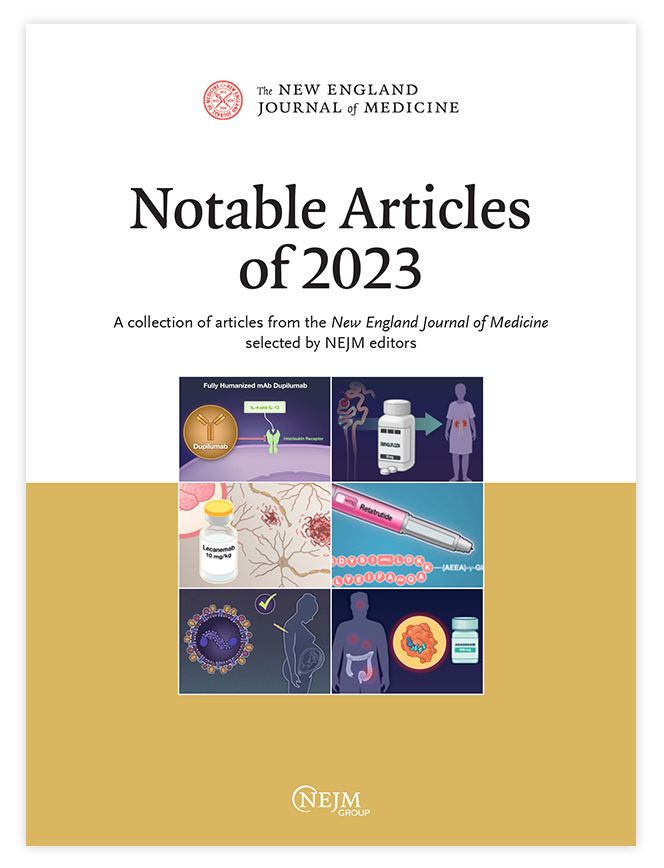卡介苗再接种预防结核分枝杆菌感染。
IF 96.2
1区 医学
Q1 MEDICINE, GENERAL & INTERNAL
引用次数: 0
摘要
背景:在之前的一项2期试验中,卡介苗(BCG)再接种没有显示出对原发性结核分枝杆菌感染的保护作用,但可以预防持续的结核分枝杆菌感染,定义为QuantiFERON-TB(一种干扰素γ释放试验)从阴性转化为阳性,随后在初始转化后3个月和6个月(次要终点)进行两次额外的QFT阳性试验。观察到疫苗效力为45%(95%可信区间[CI], 6至68)。方法:我们进行了一项2b期、双盲、随机、安慰剂对照试验,以评估卡介苗再接种与安慰剂相比,在QFT检测阴性、人类免疫缺陷病毒(HIV)阴性的青少年中预防持续QFT检测转换(主要终点)的疗效。在二次分析中评估不良事件,在探索性分析中评估免疫原性。在改良意向治疗人群中评估疫苗疗效,其中包括所有接受随机分组、接种卡介苗或安慰剂、接种卡介苗或安慰剂后10周QFT检测为阴性的参与者;最后一个标准是为了排除接种疫苗或安慰剂前后感染结核分枝杆菌的参与者。风险比和95%置信区间由分层Cox比例风险模型估计。结果随机分组共1836名受试者;918人接种卡介苗,917人接种安慰剂。中位随访30个月后,871名bcg疫苗组参与者中有62名持续QFT测试转换,849名安慰剂组参与者中有59名持续QFT测试转换。持续QFT试验转换(卡介苗与安慰剂)的风险比为1.04 (95% CI, 0.73至1.48),疫苗疗效点估计为-3.8% (95% CI, -48.3至27.4)。与安慰剂组相比,bcg疫苗组的不良事件发生频率更高,大多数是由于注射部位的反应(疼痛、发红、肿胀和溃疡)。卡介苗再接种诱导细胞因子阳性1型辅助性CD4 T细胞。结论qft试验阴性、hiv阴性的青少年再次接种bcg不能预防持续的结核分枝杆菌感染。(由盖茨基金会资助;ClinicalTrials.gov号码NCT04152161)。本文章由计算机程序翻译,如有差异,请以英文原文为准。
BCG Revaccination for the Prevention of Mycobacterium tuberculosis Infection.
BACKGROUND
In a previous phase 2 trial, bacille Calmette-Guérin (BCG) revaccination was not shown to provide protection from primary Mycobacterium tuberculosis infection but prevented sustained M. tuberculosis infection, defined by an initial conversion on a QuantiFERON-TB (QFT) test (an interferon-γ release assay) from negative to positive, followed by two additional positive QFT tests at 3 and 6 months after the initial conversion (a secondary end point). A vaccine efficacy of 45% (95% confidence interval [CI], 6 to 68) was observed.
METHODS
We performed a phase 2b, double-blind, randomized, placebo-controlled trial to evaluate the efficacy of BCG revaccination, as compared with placebo, for the prevention of sustained QFT test conversion (primary end point) in QFT test-negative, human immunodeficiency virus (HIV)-negative adolescents. Adverse events were assessed in a secondary analysis, and immunogenicity was assessed in an exploratory analysis. Vaccine efficacy was evaluated in the modified intention-to-treat population, which included all the participants who had undergone randomization, received the BCG vaccine or placebo, and had a negative QFT test 10 weeks after receipt of BCG vaccine or placebo; the last criterion was added to exclude participants with M. tuberculosis infection around the time that the vaccine or placebo was administered. Hazard ratios and 95% confidence intervals were estimated from a stratified Cox proportional-hazards model.
RESULTS
A total of 1836 participants underwent randomization; 918 received the BCG vaccine, and 917 received placebo. After a median 30 months of follow-up, a sustained QFT test conversion was observed in 62 of 871 participants in the BCG-vaccine group and 59 of 849 participants in the placebo group. The hazard ratio for a sustained QFT test conversion (BCG vaccine vs. placebo) was 1.04 (95% CI, 0.73 to 1.48), for a vaccine efficacy point estimate of -3.8% (95% CI, -48.3 to 27.4). Adverse events occurred more frequently in the BCG-vaccine group than in the placebo group, and most were due to injection-site reactions (pain, redness, swelling, and ulceration). BCG revaccination induced cytokine-positive type 1 helper CD4 T cells.
CONCLUSIONS
BCG revaccination in QFT-test negative, HIV-negative adolescents did not provide protection from sustained M. tuberculosis infection. (Funded by the Gates Foundation; ClinicalTrials.gov number NCT04152161.).
求助全文
通过发布文献求助,成功后即可免费获取论文全文。
去求助
来源期刊

New England Journal of Medicine
医学-医学:内科
CiteScore
145.40
自引率
0.60%
发文量
1839
审稿时长
1 months
期刊介绍:
The New England Journal of Medicine (NEJM) stands as the foremost medical journal and website worldwide. With an impressive history spanning over two centuries, NEJM boasts a consistent publication of superb, peer-reviewed research and engaging clinical content. Our primary objective revolves around delivering high-caliber information and findings at the juncture of biomedical science and clinical practice. We strive to present this knowledge in formats that are not only comprehensible but also hold practical value, effectively influencing healthcare practices and ultimately enhancing patient outcomes.
 求助内容:
求助内容: 应助结果提醒方式:
应助结果提醒方式:


